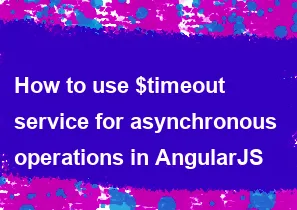How to use $timeout service for asynchronous operations in AngularJS

In AngularJS, the $timeout service is used to execute a function after a specified delay. It's often used for delaying the execution of code or for triggering code asynchronously after a certain time interval. Here's how you can use $timeout for asynchronous operations in AngularJS:
Inject
$timeoutService: Make sure to inject the$timeoutservice into your controller, service, or wherever you need to use it.javascriptangular.module('myApp').controller('MyController', function($scope, $timeout) { // Controller code here });Basic Usage: Call the
$timeoutfunction with a callback function as the first argument and the delay (in milliseconds) as the second argument. This callback function will be executed after the specified delay.javascript$timeout(function() { // Code to be executed after delay }, 1000); // 1000 milliseconds (1 second) delayReturning a Promise:
$timeoutcan also return a promise, which resolves when the specified delay has elapsed. This can be useful for chaining asynchronous operations or executing code after the delay.javascript$timeout(function() { // Code to be executed after delay // This will execute after 1 second }, 1000).then(function() { // Code to be executed after the timeout function completes // This will execute after the above code executes });Canceling a Timeout:
$timeoutreturns a promise, which can be used to cancel the timeout before it occurs using thecancel()method.javascriptvar timeoutPromise = $timeout(function() { // Code to be executed after delay }, 1000); // Cancel the timeout $timeout.cancel(timeoutPromise);
Remember, $timeout is wrapped in the AngularJS digest cycle, so any changes made to AngularJS models within the $timeout function will trigger a digest cycle and update the UI accordingly.
Here's a basic example demonstrating the use of $timeout in a controller:
javascriptangular.module('myApp').controller('MyController', function($scope, $timeout) {
$scope.message = "Initial Message";
$timeout(function() {
$scope.message = "Message after delay";
}, 2000); // Change message after 2 seconds
});
In this example, the message will change to "Message after delay" after 2 seconds.
-
Popular Post
- How to optimize for Google's About This Result feature for local businesses
- How to implement multi-language support in an Express.js application
- How to handle and optimize for changes in mobile search behavior
- How to handle CORS in a Node.js application
- How to use Vue.js with a UI framework (e.g., Vuetify, Element UI)
- How to configure Laravel Telescope for monitoring and profiling API requests
- How to create a command-line tool using the Commander.js library in Node.js
- How to implement code splitting in a React.js application
- How to use the AWS SDK for Node.js to interact with various AWS services
- How to use the Node.js Stream API for efficient data processing
- How to implement a cookie parser middleware in Node.js
- How to implement WebSockets for real-time communication in React
-
Latest Post
- How to implement a dynamic form with dynamic field styling based on user input in Next.js
- How to create a custom hook for handling user interactions with the browser's device motion in Next.js
- How to create a custom hook for handling user interactions with the browser's battery status in Next.js
- How to implement a dynamic form with dynamic field visibility based on user input in Next.js
- How to implement a dynamic form with real-time collaboration features in Next.js
- How to create a custom hook for handling user interactions with the browser's media devices in Next.js
- How to use the useSWRInfinite hook for paginating data with a custom loading indicator in Next.js
- How to create a custom hook for handling user interactions with the browser's network status in Next.js
- How to create a custom hook for handling user interactions with the browser's location in Next.js
- How to implement a dynamic form with multi-language support in Next.js
- How to create a custom hook for handling user interactions with the browser's ambient light sensor in Next.js
- How to use the useHover hook for creating interactive image zoom effects in Next.js